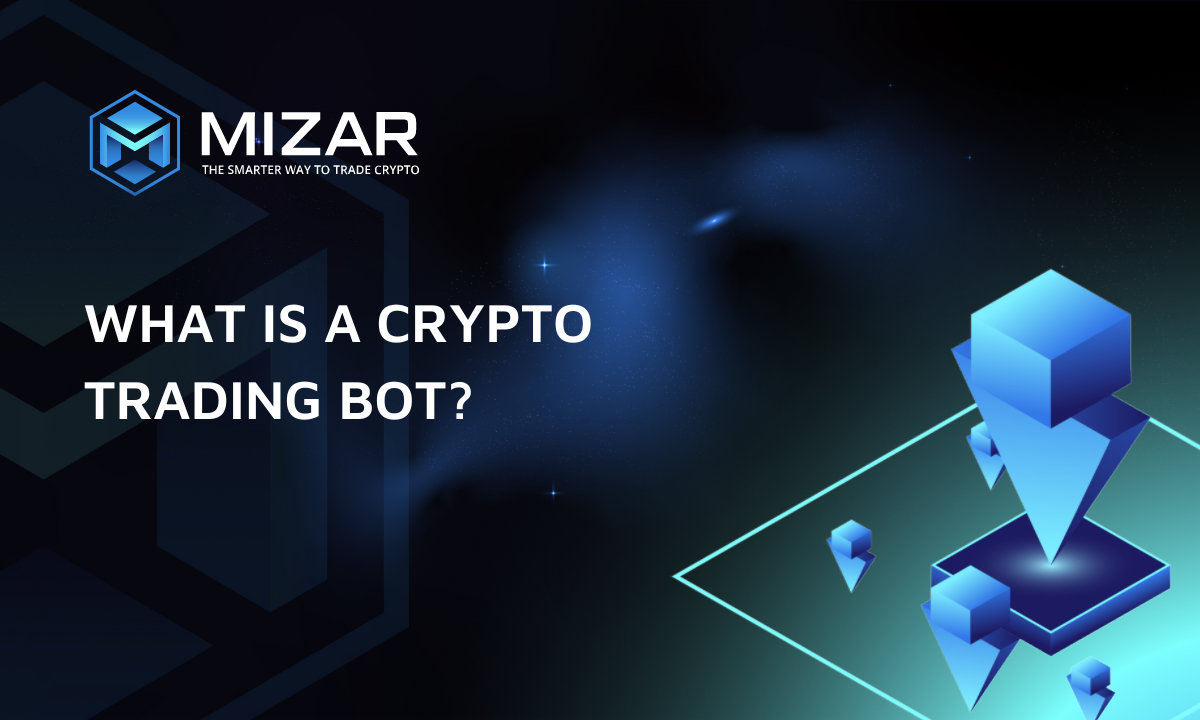What Is a Crypto Trading Bot?

Can and, more importantly, should one compete against a machine? As of writing, automated bots make up to 80% of the crypto market, responsible for order management, execution, and more. Technology is no longer a privilege but a requirement to trade successfully. This article elaborates on what trading bots are, how they work, and considers potential benefits you can get.
Key Takeaways
Trading bots are software pieces that automatically buy/sell assets based on predefined settings.
Bots can spot trading opportunities otherwise missed and execute orders automatically to secure profits.
Both newbies and experienced traders can benefit from bots, as you can either pick a one-click bot or customize it from scratch according to your trading experience.
Mizar’s crypto trading platform provides a wide range of bots you can combine with powerful order management tools for the best results. Create your bot from scratch or copy trade — both within a few clicks.
What Are Crypto Trading Bots?
A trading bot is an automated software that buys and sells crypto based on predefined settings. In other words, it’s a special program designed to facilitate your trading experience by automating menial tasks like price monitoring, order execution, and beyond.
How Do Crypto Trading Bots Work?
A trading bot executes embedded if/then rules once triggered by specific conditions. Bots closely monitor price fluctuations, indicators, and trends to secure profits.
Bot trading usually works in four stages.
1. Data analysis
2. Signal generation
3. Risk allocation
4. Execution
Data Analysis. Data is key, and analyzing it is critical to the success of any crypto bot. Machine-learning software identifies, collects, and analyzes incomparably more data than any financial analyst.
Signal generation. After processing the data, the bot does the trader's work, making predictions and identifying possible deals based on market data and technical analysis indicators.
Risk allocation. The bot distributes the risk according to a certain set of parameters the trader sets in advance and includes how much money will be used to trade.
Execution. The stage where cryptocurrencies are bought and sold based on the generated signals. The bot generates buy or sell orders and sends this information to the exchange via the API.
The steps and specific rules behind them may vary slightly — some bots allow customization, and some are rather ready-to-go trading experiences.
Crypto Trading Bots: Pros & Cons
Pros
Bots automate your exchange trading experience. There’s no need to relentlessly monitor charts and indicators.
Automated bots strictly adhere to a given algorithm. Robots are not subject to doubt and panic, as they perform without emotions. Wave farewell to any emotional losses.
Trading bots are triggered almost instantly, implying you have more chances to secure profits on emerging opportunities.
Cons
Some bots require a trading background. Think of setting specific trading parameters that directly affect your performance.
Advanced trading bots can be expensive.
Some bots are highly sensitive to unpredictable market events and difficult to be managed.
Ineffective bot strategies may cause losses.
Types of Crypto Trading Bots
There are several types of cryptocurrency bots. Let's start with the most common ones:
DCA trading bots. Dollar-cost average bots gradually lower the average entry price by investing in an asset over time. It’s a reliable investment solution regardless of market conditions or a trading background.
Grid Bots. Advanced trading robots trading between specific order levels [collectively called grid]. Grid bots work best on the sideways markets.
Script bots. Crypto bots with open-source code have a high customization potential, but you need extensive coding/trading experience to use script bots.
Signal bots. Such bots do not perform trading operations. They aggregate trading data and provide trading recommendations like entry/exit points, take profit/stop loss orders, and beyond
Less common types of bots for cryptocurrency trading include the following.
Arbitrage bots. They capitalize on price differences across trading pairs and exchanges.
Statistical arbitrage. Such robots analyze the market in search of undervalued and overvalued crypto assets. They identify patterns and set correlations across crypto assets.
There are also market-maker bots. They create market liquidity by placing bids on both sides of the order book [to buy and to sell]. Such bots are intended for working with large volumes.
How to Get Started with Crypto Trading Bots?
1. Scrutinize various bot types and ratings to choose the best option for your needs.
2. Consider running a ready-to-go bot on Mizar and customize the parameters if required.
3. Develop custom strategies — personal trading experience combined with the capabilities of Mizar order management tools will provide the best results.
Here’s a quick dive into Mizar DCA Bots, one of the easiest ways to get started with crypto trading bots.
In Closing
Bots may significantly improve your trading experience, especially if you dedicate some time to pick bots that cover your specific needs. Mizar trading bots are built for beginners and professionals alike, as you can either copy trade others or create and customize your own bot. If you don't feel confident/experienced enough to create your own bots you can always copy the bots of others and perform as they do.
FAQ
Are Trading Bots Allowed in the US?
Traders can use bots to facilitate their trading experience regardless of their geographies. Some states may or may not support specific exchanges and associated API bots, though.
Are Bots Allowed for Trading?
Bots are 100% legal as long as they meet technical and other requirements set by the law. Trading bots execute as much as 90% of the crypto market orders globally, including major countries like the US, UK, Germany, India, and more.
Are Trading Bots Profitable?
Bots may help you to secure profits if used correctly. High-end bots may streamline the menial trading experience and make it more efficient.
Why Use Trading Bots?
Trading bots are designed to make your trading experience more efficient. Newbies may use bots to secure profits regardless, learn more about the market, and hone trading skills along the way. Experienced traders may automate for better time efficiency.
